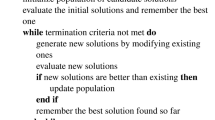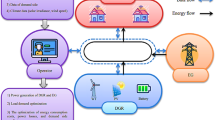Abstract
In power systems, optimal power flow (OPF) is a complex and constrained optimization problem in which quite often multiple and conflicting objectives are required to be optimized. The traditional way of dealing with multi-objective OPF (MOOPF) is the weighted sum method which converts the multi-objective OPF into a single-objective problem and provides a single solution from the set of Pareto solutions. This paper presents MOOPF study applying multi-objective evolutionary algorithm based on decomposition (MOEA/D) where a set of non-dominated solutions (Pareto solutions) can be obtained in a single run of the algorithm. OPF is formulated with two or more objectives among fuel (generation) cost, emission, power loss and voltage deviation. The other important aspect in OPF problem is about satisfying power system constraints. As the search process adopted by evolutionary algorithms is unconstrained, for a constrained optimization problem like OPF, static penalty function approach has been extensively employed to discard infeasible solutions. This approach requires selection of a suitable penalty coefficient, largely done by trial-and-error, and an improper selection may often lead to violation of system constraints. In this paper, an effective constraint handling method, superiority of feasible solutions (SF), is used in conjunction with MOEA/D to handle network constraints in MOOPF study. The algorithm MOEA/D-SF is applied to standard IEEE 30-bus and IEEE 57-bus test systems. Simulation results are analyzed, especially for constraint violation and compared with recently reported results on OPF.
















Similar content being viewed by others
Abbreviations
- CH:
-
Constraint handling
- EA:
-
Evolutionary algorithm
- HV:
-
Hypervolume
- MOEA/D:
-
Multi-objective evolutionary algorithm based on decomposition
- MOOPF:
-
Multi-objective optimal power flow
- MOP:
-
Multi-objective optimization problem
- PF:
-
Pareto front
- p.u.:
-
Per unit
- SF:
-
Superiority of feasible solutions
- VAR:
-
Volt-ampere reactive
- nl:
-
Number of transmission lines
- NB:
-
Total number of buses
- NC:
-
Number of shunt (VAR) compensators
- NG:
-
Number of generators
- NL:
-
Number of load buses
- NT:
-
Number of tap-regulated transformers
- ai, bi, ci :
-
Cost coefficients of generator i
- B ij :
-
Susceptance between buses i and j
- G ij :
-
Transfer conductance between buses i and j
- P Di :
-
Active power demand at bus i
- P Gi :
-
Active power of generator at i-th bus
- Q Ck :
-
Shunt (VAR) compensation at k-th bus
- Q Di :
-
Reactive power demand at bus i
- Q Gi :
-
Reactive power of generator at i-th bus
- S lq :
-
Loading of q-th line
- T j :
-
j-th branch transformer tap
- V j :
-
Voltage magnitude of j-th bus (either generator or load)
- VD:
-
Aggregate voltage deviation of load buses in the network
- V Gi :
-
Voltage magnitude of i-th generator bus
- V Lp :
-
Voltage magnitude of p-th load bus
- \( \alpha_{i} , \beta_{i} , \gamma_{i} ,\omega_{i} , \mu_{i} \) :
-
Emission coefficients of generator i
- δ j :
-
Voltage angle at bus j
- δ ij :
-
Voltage angle difference between buses i and j
References
Abaci K, Yamacli V (2016) Differential search algorithm for solving multi-objective optimal power flow problem. Int J Electr Power Energy Syst 79:1–10
Alsac O, Stott B (1974) Optimal load flow with steady-state security. IEEE Trans Power Appar Syst 3:745–751
Barocio E, Regalado J, Cuevas E, Uribe F, Zúñiga P, Torres PJR (2017) Modified bio-inspired optimisation algorithm with a centroid decision-making approach for solving a multi-objective optimal power flow problem. IET Gener Transm Distrib 11(4):1012–1022
Bhowmik AR, Chakraborty AK (2015) Solution of optimal power flow using non-dominated sorting multi objective opposition based gravitational search algorithm. Int J Electr Power Energy Syst 64:1237–1250
Bilel N, Mohamed N, Zouhaier A, Lotfi R (2016) An improved imperialist competitive algorithm for multi-objective optimization. Eng Optim 48(11):1823–1844
Biswas PP, Suganthan PN (2018) Multiobjective evolutionary optimization. Encycl Electr Electr Eng. https://doi.org/10.1002/047134608X.W8380
Biswas PP, Mallipeddi R, Suganthan PN, Amaratunga GA (2017a) A multiobjective approach for optimal placement and sizing of distributed generators and capacitors in distribution network. Appl Soft Comput 60:268–280
Biswas PP, Suganthan PN, Amaratunga GA (2017b) Optimal power flow solutions incorporating stochastic wind and solar power. Energy Convers Manag 148:1194–1207
Biswas PP, Suganthan PN, Mallipeddi R, Amaratunga GA (2018a) Optimal power flow solutions using differential evolution algorithm integrated with effective constraint handling techniques. Eng Appl Artif Intell 68:81–100
Biswas PP, Suganthan PN, Amaratunga GA (2018b) Decomposition based multi-objective evolutionary algorithm for windfarm layout optimization. Renew Energy 115:326–337
Biswas PP, Suganthan PN, Qu BY, Amaratunga GA (2018c) Multiobjective economic-environmental power dispatch with stochastic wind-solar-small hydro power. Energy 150:1039–1057
Bouchekara HREH, Chaib AE, Abido MA, El-Sehiemy RA (2016) Optimal power flow using an improved colliding bodies optimization algorithm. Appl Soft Comput 42:119–131
Bringmann K, Friedrich T (2013) Approximation quality of the hypervolume indicator. Artif Intell 195:265–290
Chaib AE, Bouchekara HREH, Mehasni R, Abido MA (2016) Optimal power flow with emission and non-smooth cost functions using backtracking search optimization algorithm. Int J Electr Power Energy Syst 81:64–77
Chen G, Yi X, Zhang Z, Wang H (2018) Applications of multi-objective dimension-based firefly algorithm to optimize the power losses, emission, and cost in power systems. Appl Soft Comput 68:322–342
Davoodi E, Babaei E, Mohammadi-ivatloo B (2018) An efficient covexified SDP model for multi-objective optimal power flow. Int J Electr Power Energy Syst 102:254–264
Deb K (2000) An efficient constraint handling method for genetic algorithms. Comput Methods Appl Mech Eng 186(2):311–338
Ghasemi M, Ghavidel S, Ghanbarian MM, Massrur HR, Gharibzadeh M (2014a) Application of imperialist competitive algorithm with its modified techniques for multi-objective optimal power flow problem: a comparative study. Inf Sci 281:225–247
Ghasemi M, Ghavidel S, Ghanbarian MM, Gharibzadeh M, Vahed AA (2014b) Multi-objective optimal power flow considering the cost, emission, voltage deviation and power losses using multi-objective modified imperialist competitive algorithm. Energy 78:276–289
Ghasemi M, Ghavidel S, Ghanbarian MM, Gitizadeh M (2015) Multi-objective optimal electric power planning in the power system using Gaussian bare-bones imperialist competitive algorithm. Inf Sci 294:286–304
Mallipeddi R, Suganthan PN (2010) Ensemble of constraint handling techniques. IEEE Trans Evol Comput 14(4):561–579
Mallipeddi R, Jeyadevi S, Suganthan PN, Baskar S (2012) Efficient constraint handling for optimal reactive power dispatch problems. Swarm Evolut Comput 5:28–36
Miettinen K (2017) Nonlinear multiobjective optimization, vol 12. Springer, Berlin
Mohamed AAA, Mohamed YS, El-Gaafary AA, Hemeida AM (2017) Optimal power flow using moth swarm algorithm. Electr Power Syst Res 142:190–206
Morshed MJ, Hmida JB, Fekih A (2018) A probabilistic multi-objective approach for power flow optimization in hybrid wind-PV-PEV systems. Appl Energy 211:1136–1149
Niknam T, rasoul Narimani M, Jabbari M, Malekpour AR (2011) A modified shuffle frog leaping algorithm for multi-objective optimal power flow. Energy 36(11):6420–6432
Nuaekaew K, Artrit P, Pholdee N, Bureerat S (2017) Optimal reactive power dispatch problem using a two-archive multi-objective grey wolf optimizer. Expert Syst Appl 87:79–89
Powell D, Skolnick MM (1993) Using genetic algorithms in engineering design optimization with non-linear constraints. In: Proceedings of the 5th international conference on genetic algorithms. Morgan Kaufmann Publishers Inc, pp 424–431
Pulluri H, Naresh R, Sharma V (2017) An enhanced self-adaptive differential evolution based solution methodology for multiobjective optimal power flow. Appl Soft Comput 54:229–245
Rahmani S, Amjady N (2017) Improved normalised normal constraint method to solve multi-objective optimal power flow problem. IET Gener Transm Distrib 12(4):859–872
Reddy SS (2017) Solution of multi-objective optimal power flow using efficient meta-heuristic algorithm. Electr Eng 100:1–13
Shabanpour-Haghighi A, Seifi AR, Niknam T (2014) A modified teaching–learning based optimization for multi-objective optimal power flow problem. Energy Convers Manag 77:597–607
Shaheen AM, Farrag SM, El-Sehiemy RA (2017) MOPF solution methodology. IET Gener Transm Distrib 11(2):570–581
Srinivas N, Deb K (1994) Muiltiobjective optimization using nondominated sorting in genetic algorithms. Evol Comput 2(3):221–248
Trivedi A, Srinivasan D, Pal K, Saha C, Reindl T (2015) Enhanced multiobjective evolutionary algorithm based on decomposition for solving the unit commitment problem. IEEE Trans Ind Inf 11(6):1346–1357
Warid W, Hizam H, Mariun N, Wahab NIA (2018) A novel quasi-oppositional modified Jaya algorithm for multi-objective optimal power flow solution. Appl Soft Comput 65:360–373
While L, Hingston P, Barone L, Huband S (2006) A faster algorithm for calculating hypervolume. IEEE Trans Evol Comput 10(1):29–38
Yu X, Yu X, Lu Y, Sheng J (2018) Economic and emission dispatch using ensemble multi-objective differential evolution algorithm. Sustainability 10(2):418
Yuan X, Zhang B, Wang P, Liang J, Yuan Y, Huang Y, Lei X (2017) Multi-objective optimal power flow based on improved strength Pareto evolutionary algorithm. Energy 122:70–82
Zhang Q, Li H (2007) MOEA/D: a multiobjective evolutionary algorithm based on decomposition. IEEE Trans Evol Comput 11(6):712–731
Zhang Q, Liu W, Li H (2009) The performance of a new version of MOEA/D on CEC09 unconstrained MOP test instances. In: IEEE congress on evolutionary computation, 2009. CEC’09. IEEE, pp 203–208
Zhang J, Tang Q, Li P, Deng D, Chen Y (2016) A modified MOEA/D approach to the solution of multi-objective optimal power flow problem. Appl Soft Comput 47:494–514
Zhao SZ, Suganthan PN, Zhang Q (2012) Decomposition-based multiobjective evolutionary algorithm with an ensemble of neighborhood sizes. IEEE Trans Evol Comput 16(3):442–446
Zimmerman RD, Murillo-Sánchez CE, Thomas RJ (2018) Matpower. http://www.pserc.cornell.edu/matpower. Accessed Apr 2018
Funding
This work is supported by the Singapore National Research Foundation (NRF) under its Campus for Research Excellence and Technological Enterprise (CREATE) program.
Author information
Authors and Affiliations
Corresponding author
Ethics declarations
Conflict of interest
All the authors declare that they have no conflict of interest.
Ethical approval
This article does not contain any studies with human participants or animals performed by any of the authors.
Additional information
Communicated by V. Loia.
Publisher’s Note
Springer Nature remains neutral with regard to jurisdictional claims in published maps and institutional affiliations.
Rights and permissions
About this article
Cite this article
Biswas, P.P., Suganthan, P.N., Mallipeddi, R. et al. Multi-objective optimal power flow solutions using a constraint handling technique of evolutionary algorithms. Soft Comput 24, 2999–3023 (2020). https://doi.org/10.1007/s00500-019-04077-1
Published:
Issue Date:
DOI: https://doi.org/10.1007/s00500-019-04077-1




